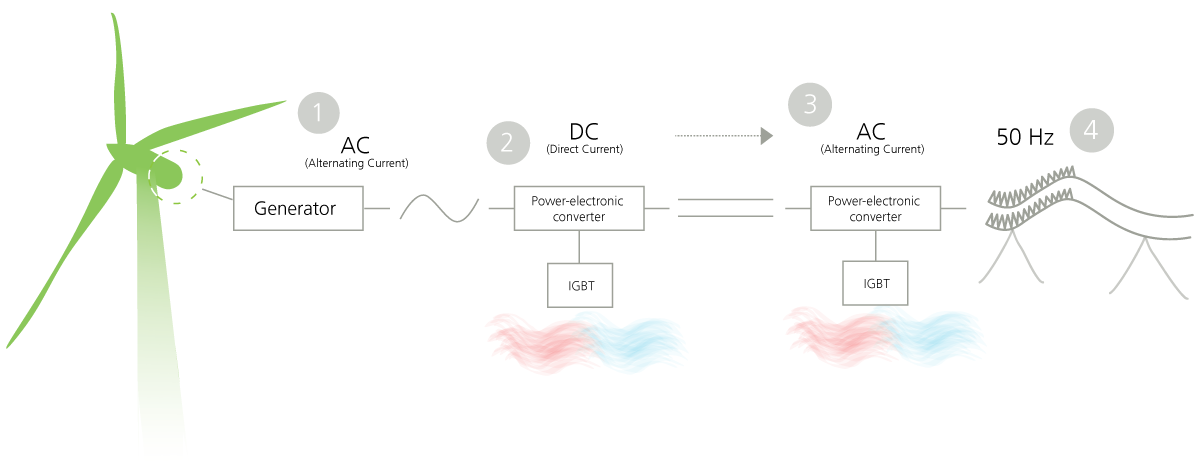How quick connect couplings reduce wind turbine maintenance costs and help to prevent IGBT failures

Power-electronic converters in wind power turbines are critical components. They are shown to be one of the most frequently failing parts, according to an article from MDPI (source: MDPI). The most common cause for this is the failure of successfully dissipating the heat, resulting in a standstill, revenue losses, and high maintenance costs. With effective thermal management using quick couplings, this can be reduced, and the IGBT service life extended.
The fast-moving development within power-electronics has increased demand for more efficient and modern ways of dissipating heat. Unfortunately, failure in effectively dissipating the heat is a common issue resulting in reduced efficiency in the system, or, in the worst case, system failure.
The critical part in a power-electronic converter is the electronic transistor, i.e. IGBT (Insulated Gate Bipolar Transistor). The massive heat generation often requires a liquid cooling system for thermal management. Below is an example of a sequence of events when current is converted through an electronic transistor in a power electronic converter:
- The generator in the wind power turbine generates AC
- The AC is then converted to DC, which puts thermal stress on the IGBT.
- The DC is then converted to AC again with the right voltage and frequency, which...
- ...then goes out in the grid. Just as above, this puts thermal stress on the IGBT. Failure in effectively dissipating the heat, the IGBT are at risk to burn out, resulting in system failure and standstill.
Avoid costly IGBT failures due to insufficient cooling
When unable to effectively handle high temperatures in power-electronic converters in wind power turbines, resulting in a thermal runaway with a reduced life-time, or even, in worst cases, burning modules, the consequences can be a costly lesson. In fact, except for downtime and revenue losses, the maintenance costs of a failing IGBT can go up to €100.000 per day, especially if the wind power is located off-shore where ships, cranes or helicopters are involved. Therefore, investing in high-quality components in the thermal management system is highly important to avoid unnecessary and costly failures.
Quick couplings enable working with pre-filled modules
When disaster strikes and the IGBT has reached the end of its service life, a smart design using quick couplings will make the on-field maintenance job much quicker and keep the production loss at a minimum. Complete IGBT modules with pre-filled cooling fluid can easily be connected without the need for draining and filling inside the confined space in the nacelle. Using high-quality non-drip quick couplings, there is no hassle with spills or leaks. Disconnect existing IGBT module, connect the new module and it’s ready to go. The burned out module can then be taken back to the workshop for draining, IGBT replacement, and filling.
Furthermore, using quick connect couplings instead of other solutions is beneficial in the sense that they expedite the assembly and installation process, which otherwise is a time-consuming process resulting in high converter production costs. Since quick connect couplings do not require tightening with torque precision, which often is a difficult task to perform on flange connections as they are more difficult to access, these production costs can be reduced.
Designed to withstand vibrations
Another major challenge with wind power turbines is mechanical vibrations. The vibrations are often caused when screws, nuts, and bolts loosen during operation. The vibrations can also cause flanges to loosen and thereby create a leak in a closed cooling circuit. Just as overheating, this may cause high maintenance costs. This is something that reliable and high quality quick connect couplings can prevent.
CEJNs ultraFLOW series of quick connect couplings can be a benefit when disconnecting parts of a circuit. It will shut off sections in the converter system and guarantee no spillage – a feature that is not possible in traditional ball valves.
Using CEJN ultraFLOW couplings, the operator only needs to drain a limited amount of the coolant from the system as opposed to up to 200 liters. This is an important time-saving function which puts greater effect in both wind turbine uptime and associated costs.
Five reasons to choose CEJN ultraFLOW
- Guaranteed no-spill
- Unequalled low pressure-drop
- Functional and leak-tested to ensure reliability
- UltraFLOW is tested and approved according to the Stringent Railroad standard Shock and vibration standard EN 61373:2010 to ensure a robust product.
- Available in hard-coated high strength aluminum to make them light-weight, or in stainless steel for corrosive environments
Read more about ultraFLOW and our solutions for thermal management >
Quick Connect Couplings:
A Critical Component in Liquid Thermal Management Solutions
Related Stories

Shaping the future of liquid cooling technology in data centers: CEJN and the Open Compute Project (OCP)
The data center industry is undergoing huge technology shifts at a rapid pace. With advanced technologies demanding more power and efficiency, greater stress is put on thermal management systems. To meet the increasing cooling requirements, CEJN is actively contributing to the Open Compute Project (...

Universal Quick Disconnects (UQD) – open standard couplings now available in two sizes
CEJN now has two sizes of the UQD universal quick disconnects available. It is a reliable and easy-to-use quick coupling for liquid cooling in data centers developed upon an initiative by Intel as an...

PON Equipment builds world’s biggest battery-electric excavators – equipped with CEJN ultraFLOW
Pon Equipment, the Norwegian dealer of Caterpillar machines, is now bringing heavy-duty battery-electric excavators of 12 and 25-tons into the global market. At this level of power, an efficient...

